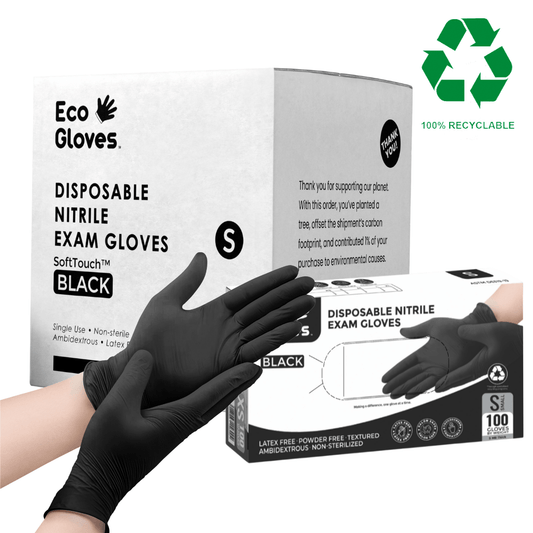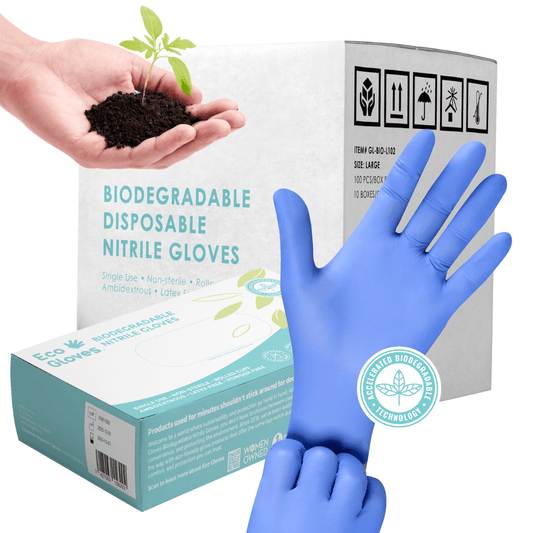What Makes Compostable Gloves Better for the Environment?
Eco GlovesIn an era where single-use plastics are under heavy scrutiny, compostable gloves are becoming a popular and responsible choice for eco-conscious consumers and businesses. But what exactly makes compostable gloves better for the environment? In this blog, we’ll explore what compostable gloves are, how they’re different from other disposable glove types, the environmental impact of using them, and answer some of the most common questions people have.
Topics Covered
- What Are Compostable Gloves?
- How Compostable Gloves Are Better for the Environment
- Environmental Impact of Production
- Compostable vs. Biodegradable: What's the Difference?
- Compostable Gloves vs. Standard PE, TPE, or HDPE Gloves
- Addressing Concerns About Compostable Gloves
- Certifications and Standards to Look For
- Where to Buy Compostable Gloves
- Key Takeaways: Why Compostable Gloves Are Better for the Environment
- Frequently Asked Questions About Compostable Gloves
What Are Compostable Gloves?
Compostable gloves are single-use gloves made from plant-based renewable resources, typically starches derived from corn, cassava, or other crops. Unlike traditional plastic gloves, these gloves are designed to break down naturally in composting environments, returning to the earth without leaving toxic residues behind.
What Are They Made Of?
Most compostable gloves are made from bioplastics like PLA (polylactic acid) or PBAT (polybutylene adipate terephthalate) combined with natural starches. These materials are non-toxic, petroleum-free, and offer an eco-friendly alternative to conventional polyethylene (PE), thermoplastic elastomer (TPE), or nitrile gloves.
How Compostable Gloves Are Better for the Environment
Switching to compostable gloves offers several environmental benefits:
1. Made from Renewable Resources
Compostable gloves are produced using materials derived from plants and other renewable sources, unlike standard plastic gloves made from fossil fuels. This dramatically reduces the carbon footprint during production and lessens our reliance on non-renewable petroleum products.
2. Break Down Faster Than Traditional Gloves
When composted properly, these gloves decompose within 90 to 120 days, turning into nutrient-rich compost. In contrast, traditional plastic gloves can take hundreds of years to degrade, if at all, contributing to long-term waste and pollution in landfills and oceans.
3. End-of-Life Solution
Disposables are often criticized for their waste. Compostable gloves offer a clear end-of-life plan—composting. This keeps them out of landfills and incinerators and helps enrich soil, closing the loop in the product lifecycle.
Environmental Impact of Production
The production of compostable gloves is more eco-efficient than conventional gloves in multiple ways:
-
Lower energy consumption due to less intensive manufacturing processes.
-
Reduced greenhouse gas emissions, especially when composted instead of incinerated.
-
Minimal to zero microplastic pollution, since compostable materials break down into natural elements.
In short, compostable gloves represent a low-impact product lifecycle, from manufacturing to disposal.
Compostable vs. Biodegradable: What's the Difference?
The terms “compostable” and “biodegradable” are often used interchangeably, but they don’t mean the same thing—and understanding the difference is crucial when choosing environmentally responsible disposable gloves.
Compostable Means Biodegradable—But Not All Biodegradable Is Compostable
Biodegradable simply means a material can eventually break down through the action of natural organisms like bacteria, fungi, and microbes. However, this process can take years—or even decades—and it doesn’t guarantee that the material breaks down into harmless or useful components. Many so-called “biodegradable” items may still leave behind microplastics or toxic residue, and most only degrade under specific conditions, such as in an active landfill environment.
Compostable, on the other hand, refers to materials that are not only biodegradable, but also break down quickly (usually within 90 to 180 days) in a controlled composting environment and leave behind no harmful residue. Compostable products return to the earth as safe, nutrient-rich fertilizer, making them part of a true closed-loop cycle.

Compostable Gloves

Compostable gloves—like Eco Gloves’ Compostable Gloves—are made from biodegradable, plant-derived materials, such as cornstarch and PLA (polylactic acid) bioplastics. These gloves are designed to break down in industrial composting facilities, and in some cases, in home composting systems, depending on the certification and compost conditions.
When composted properly, they leave behind no microplastics, no toxic residue, and no lasting waste. Instead, they decompose into CO₂, water, and biomass—natural elements that enrich the soil.
These gloves are best for light-duty applications, such as food handling, hospitality, and general hygiene tasks, and provide a sustainable alternative to petroleum-based disposables.
Biodegradable Gloves

Gloves labeled as “biodegradable” (such as Eco Gloves’ Biodegradable Nitrile Gloves) typically refer to accelerated biodegradable technology. These gloves are made from traditional nitrile blended with a special organic additive that enhances the glove’s ability to biodegrade in biologically active landfills within a truncated amount of time.
Here’s how it works: the additive turns the glove into a polymerized food source that attracts microbes. These microbes break down the gloves over time—usually within 1 to 10 years, depending on the glove’s thickness, brand, and technology used. In contrast, standard nitrile gloves can take hundreds of years to break down, if at all.
While biodegradable gloves still offer durability and protection against chemicals and pathogens, they are not designed to break down in compost bins and should not be considered compostable.
Compostable Gloves vs. Standard PE, TPE, or HDPE Gloves
When comparing compostable gloves to standard disposable options like PE (polyethylene), TPE (thermoplastic elastomer), or HDPE (high-density polyethylene) gloves, there are a few key differences to consider—especially in terms of environmental impact, durability, and usability.
Compostable gloves are made from plant-based bioplastics, such as PLA and cornstarch, and are designed to break down completely in composting environments, leaving behind no toxic residue. They offer a sustainable alternative to conventional plastic gloves and are ideal for light food handling, hospitality, and short-term tasks. These gloves tend to have a moderate thickness, which provides better durability than ultra-thin HDPE gloves, while still being comfortable and flexible enough for everyday use.
In contrast, PE and HDPE gloves are made from fossil fuel-based plastics and are extremely thin and loose-fitting. They're commonly used in low-risk settings like delis or gas stations due to their low cost and minimal durability. TPE gloves, while slightly stronger and stretchier than HDPE, are still single-use and non-compostable. Although they offer better elasticity and a more form-fitting feel than PE, they still fall short in terms of environmental responsibility. None of these standard plastic gloves are designed to break down naturally—they can persist in landfills or the environment for hundreds of years, contributing to long-term plastic pollution.
| Feature | Compostable Gloves | PE / TPE / HDPE Gloves |
|---|---|---|
| Durability & Strength | Ideal for light-duty tasks | Varies—HDPE is very thin, TPE is stretchier |
| Thickness | Moderate – thicker than HDPE, thinner than nitrile | HDPE: very thin; TPE: moderate |
| Shelf Life | 12 months (sealed) | Up to 3–5 years (plastic-based) |
| Eco Impact | Compostable, plant-based | Non-compostable, fossil fuel-based |
| Breakdown | 90–120 days in compost | 100+ years in landfill |
Another important difference is shelf life and material stability. Compostable gloves typically have a shelf life of 12 months, but they remain intact during normal use and storage when kept in a cool, dry place. Standard plastic gloves may last longer on the shelf, but their disposal results in lasting waste. Overall, compostable gloves offer a compelling alternative for eco-conscious consumers who value sustainability without compromising functionality for everyday tasks.
Addressing Concerns About Compostable Gloves
Despite their eco-appeal, compostable gloves come with some limitations:
-
Must Be Composted: These gloves won’t break down in a regular trash bin or landfill. They need to be sent to an industrial composting facility or composted at home (if accepted).
-
Not Heat- or Acid-Resistant: Due to the plant-based material, they are not ideal for hot foods or acidic sauces.
-
Shorter Shelf Life: With a 12-month shelf life, it’s important to use or rotate inventory within 9 months for best performance.
Still, when used in the right settings and composted correctly, their benefits far outweigh these concerns.
Certifications and Standards to Look For
When shopping for compostable gloves, make sure they carry recognized certifications that verify their environmental claims:
✅ ASTM D6400: U.S. standard for compostability
✅ EN 13432: European standard for compostability
✅ BPI Certified: Verified by Biodegradable Products Institute
✅ FDA Compliant for Food Handling: Safe for light food contact
These certifications ensure that the gloves meet strict criteria for safety, compostability, and performance.
Where to Buy Compostable Gloves
Compostable gloves can be found through a variety of retailers, both online and in stores. They are most commonly available at eco-friendly and sustainable living stores that prioritize environmentally responsible products. Some natural food markets, zero-waste shops, or green supply distributors may also carry compostable gloves for personal or business use. For those looking for a trusted option, Eco Gloves offers a line of certified compostable gloves available for purchase at www.ecogloves.co or through Amazon, with options for individual orders, bulk cases, or wholesale partnerships tailored to your needs.
Final Thoughts
As we continue to seek out smarter, more sustainable alternatives to everyday single-use products, compostable gloves offer a meaningful way to reduce environmental impact without compromising on functionality. Made from renewable, plant-based materials, these gloves provide a responsible end-of-life solution—breaking down quickly and safely in composting environments without leaving behind harmful residue, microplastics, or toxic chemicals.
While they may not be suitable for every application, compostable gloves are an excellent choice for light food handling, hospitality, and general hygiene tasks where sustainability matters. Compared to standard plastic gloves that can take centuries to decompose, compostable gloves represent a step forward in creating a more circular and eco-conscious economy.
At Eco Gloves, we’re committed to offering high-quality, certified compostable gloves that help individuals and businesses reduce waste and make greener choices. Whether you're a foodservice professional, an eco-conscious consumer, or a business looking to minimize your carbon footprint, switching to compostable gloves is a small change that makes a big difference.
Key Takeaways: Why Compostable Gloves Are Better for the Environment
-
Plant-Based Materials: Made from renewable resources like cornstarch, PLA, and PBAT instead of fossil fuels.
-
Fast Decomposition: Break down within 90–120 days in composting environments, compared to centuries for plastic gloves.
-
No Toxic Residue: Leave behind only CO₂, water, and nutrient-rich biomass—no microplastics or harmful chemicals.
-
Lower Production Impact: Require less energy, produce fewer greenhouse gases, and generate zero microplastic pollution.
-
True End-of-Life Solution: Composting keeps gloves out of landfills and creates nutrient-rich soil.
-
Certified Compostable: Standards like ASTM D6400, EN 13432, and BPI certification verify environmental claims and safety.
👉 Compostable gloves offer a responsible, closed-loop alternative to traditional plastics—helping individuals and businesses reduce waste while protecting the planet.
Frequently Asked Questions About Compostable Gloves
-
What is the shelf life of compostable gloves?
About 12 months when stored properly; for best results, use within 9 months to maintain seam integrity.
-
Can compostable gloves handle hot or acidic foods?
No. They’re not suitable for high-heat or acidic applications; best for light food prep, serving, and general tasks.
-
Do compostable gloves contain harmful chemicals?
No. They’re free from PFAs, phthalates, BPA, heavy metals, and other toxic additives.
-
Are compostable gloves the same as biodegradable gloves?
No. All compostable gloves are biodegradable, but not all biodegradable gloves are compostable. Compostable gloves break down faster and leave no harmful residue.
-
How should compostable gloves be disposed of?
In industrial composting facilities or home compost systems (if certified), they won’t break down properly in landfills.
-
What tasks are compostable gloves best suited for?
Light-duty applications like food handling, hospitality, and general hygiene, where sustainability is a priority.
Related Reading
- Are Biodegradable Gloves Really Better for the Planet?
- Top 5 Gloves Safe for Sensitive Skin
-
How to Properly Dispose of Disposable Gloves
- Compostable vs. Biodegradable: What’s the Difference?
Ready to make the switch? Shop Eco Gloves’ Compostable Gloves now and help build a greener, cleaner world—one pair of gloves at a time.
















